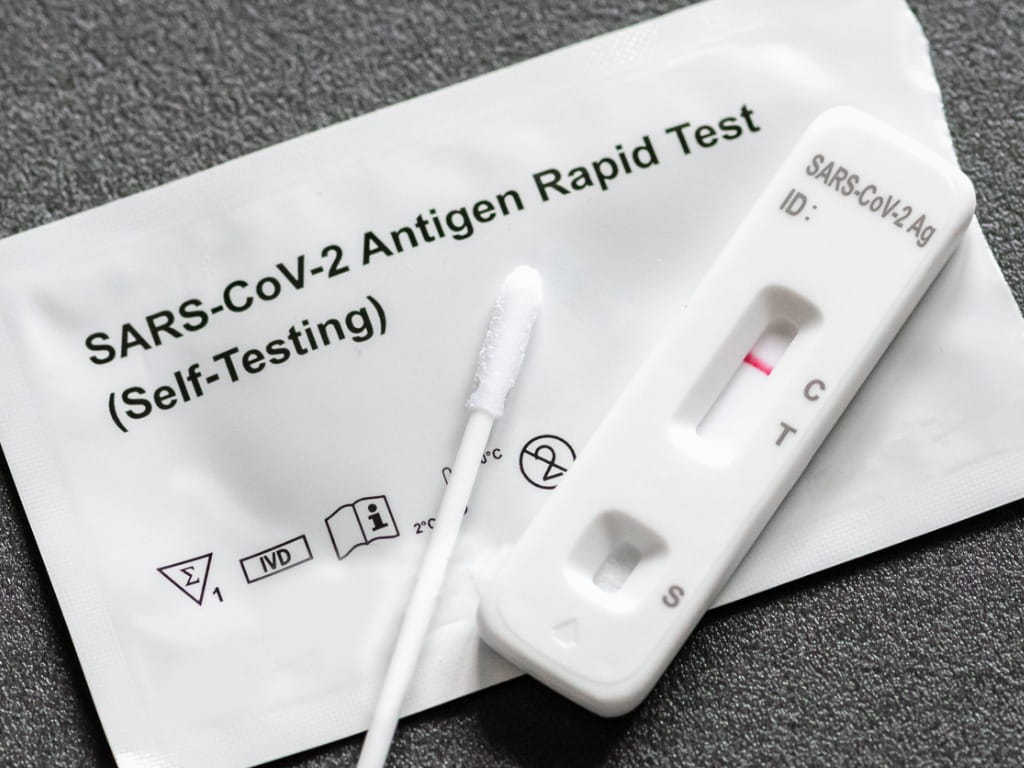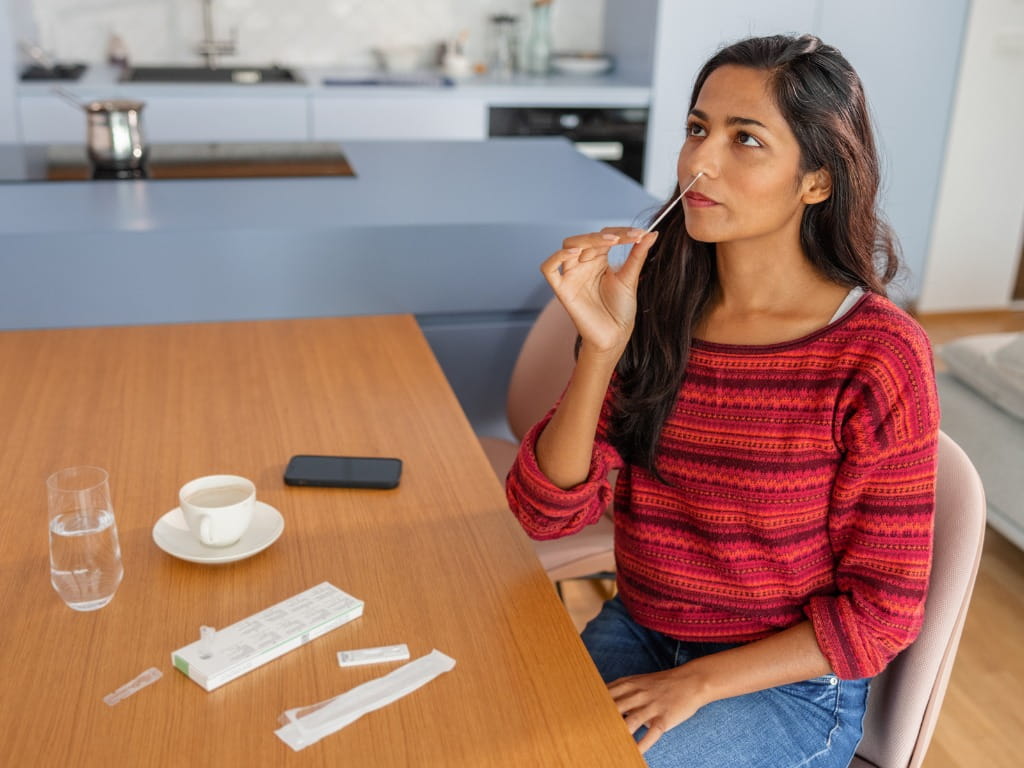I Swallowed Liquid From a COVID-19 Test Kit

The Bottom Line
Many rapid home COVID-19 antigen tests contain a small amount of the toxic chemical sodium azide, but the risk of poisoning is low when these tests are used and disposed of properly.

At-home COVID-19 testing
An antigen is a substance that triggers an immune response when the body encounters it. Rapid COVID-19 antigen tests detect specific antigens present on the surface of the coronavirus collected with a nasal swab. Results can be available in as little as 15 minutes, depending on the brand of test used. Because of this, rapid antigen tests can be used for early identification of COVID-19 infection at home. This helps with public health efforts to limit the spread of COVID-19 and is particularly important as many outpatient testing sites and hospitals are overwhelmed when cases of the virus surge in the community.
COVID-19 rapid antigen tests are available online and in stores and may be distributed in schools, government agencies, and community sites. These test kits generally contain a nasal swab, a capped vial with liquid in it, a testing strip, and a set of instructions. While procedures vary between brands, the testing process usually involves swabbing both nostrils. This is followed by mixing the test swab with the liquid in the vial and applying a specific amount of the liquid onto the test strip. This generates a chemical reaction that provides a positive or negative test result.
What is the liquid in COVID-19 test kits?
The liquid in COVID-19 test kits is primarily saline (salt water). It also contains small amounts of buffering chemicals to maintain the acidity (pH) of the solution at about 7.4, the same as the human body. The accuracy of the test depends on maintaining this pH in the test liquid. The liquid can also include a tiny amount of a preservative like sodium azide.How does the liquid work?
The liquid is used to transfer any virus particles (antigens) collected by the swab to the test strip, which is embedded with antibodies. If there are COVID-19 antigens in the liquid, they interact with the antibodies, and a positive result is visible.Which testing kids contain sodium azide?
The Abbott BinaxNow, BD Veritor, ACONlab Flowflex, and Celltrion DiaTrust, GenBody, Nano-Ditech Nano-Check, OSANG OHC, and Siemens CLINITEST COVID-19 rapid antigen kits are known to contain sodium azide as a preservative. There are many other testing products, and it is likely that many of them also contain sodium azide.Sodium azide: What is it?
Sodium azide is a colorless, tasteless, and odorless powder that has been used as a propellant in automobile airbags, an herbicide, and a pest control agent. While it is now most frequently utilized as a laboratory preservative agent, sodium azide has also been used during the process of manufacturing beer, wine, and rubber.Is sodium azide dangerous?
When swallowed, sodium azide can cause low blood pressure, dizziness, headache, and heart palpitations. In more severe cases, seizures, loss of consciousness, and death can occur. Sodium azide is a very potent poison, and swallowing even small amounts can cause serious poisoning. Fortunately, the amount of sodium azide in most COVID-19 rapid antigen kits is much smaller than the amount expected to cause poisoning if swallowed by an adult. However, the vials that come with the kits do look like small squeeze bottles or eye droppers. Some people might accidentally confuse them with medications and apply the drops into their eyes or nose, which can cause irritation. People also might spill it on their skin, which can cause skin irritation or chemical burns. Small children might accidentally swallow the contents of the vial or choke on the vial’s small cap.What to do if you are having a bad reaction
If you suspect someone has swallowed sodium azide, do not make the person vomit. For eye exposures, rinse the eyes for 15–20 minutes with warm tap water. For skin exposures, rinse the skin well with tap water. Immediately check the webPOISONCONTROL online tool for guidance or call Poison Control at 1-800-222-1222. Both options are free and available 24 hours a day. If someone has swallowed part of a rapid antigen test and is choking, call 911 immediately.Maryann Amirshahi, PharmD, MD, MPH, PhD
Medical Toxicologist
Revised William G. Troutman, PharmD
Professor of Pharmacy Emeritus
Poison Control Media Information
Did you find this page helpful? If so, we need your support. Poison Control is in constant competition with misinformation online. Links to www.poison.org or our webPOISONCONTROL triage tool from other websites and blogs help internet searchers quickly find accurate information and Poison Control’s contact information in an emergency. If you use the content from this page, please provide attribution via a link back to this page, www.poison.org, or https://triage.webpoisoncontrol.org/#!/exclusions. By doing so, you could save a life. Thank you!
Poisoned?
Call 1-800-222-1222 or
Prevention Tips
- Store COVID-19 rapid antigen test kits away from children and do not open a kit until you intend to use it.
- Read the directions for use and follow them carefully.
- Do not let children handle or play with rapid antigen kits.
- Dispose of the test kit immediately after use.
- COVID-19 infection is best prevented through vaccination, wearing masks, hand washing, and maintaining social distancing.
This Really Happened
Case 1. An adult couple misunderstood the directions on a COVID-19 home testing kit and put the test kit solution in their nose with the swab. They had mild nasal irritation, which was resolved with nasal saline spray.
Case 2. An adult woman mistook the test kit vial from her home COVID-19 test for her antibiotic eye drops and put drops of it in her eye. She developed some irritation and redness in the eye, which resolved after rinsing the eye with water for 10 minutes.
Case 3. A woman got a small amount of sodium azide-containing fluid on her thumb after performing a rapid COVID-19 antigen test at home. Her thumb was tingling, flushed, and mildly swollen. She ran her thumb under water, and her symptoms resolved within a couple of hours.
Case 4. A 3-year-old boy grabbed a COVID-19 test kit vial from the counter and put it in his mouth. His mother called Poison Control, and she rinsed his mouth out. The boy developed no symptoms.
For More Information
References
Poisoned?
Call 1-800-222-1222 or
Prevention Tips
- Store COVID-19 rapid antigen test kits away from children and do not open a kit until you intend to use it.
- Read the directions for use and follow them carefully.
- Do not let children handle or play with rapid antigen kits.
- Dispose of the test kit immediately after use.
- COVID-19 infection is best prevented through vaccination, wearing masks, hand washing, and maintaining social distancing.
This Really Happened
Case 1. An adult couple misunderstood the directions on a COVID-19 home testing kit and put the test kit solution in their nose with the swab. They had mild nasal irritation, which was resolved with nasal saline spray.
Case 2. An adult woman mistook the test kit vial from her home COVID-19 test for her antibiotic eye drops and put drops of it in her eye. She developed some irritation and redness in the eye, which resolved after rinsing the eye with water for 10 minutes.
Case 3. A woman got a small amount of sodium azide-containing fluid on her thumb after performing a rapid COVID-19 antigen test at home. Her thumb was tingling, flushed, and mildly swollen. She ran her thumb under water, and her symptoms resolved within a couple of hours.
Case 4. A 3-year-old boy grabbed a COVID-19 test kit vial from the counter and put it in his mouth. His mother called Poison Control, and she rinsed his mouth out. The boy developed no symptoms.
